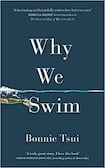
It’s quite late into this kaleidoscopic exploration of why human beings are drawn to water that Bonnie Tsui lets slip that she saved a child from drowning in her years as a teenage lifeguard. “Those eyes, underwater, big as dinner plates,” she remembers, of the seconds when she successfully located and saved the child in the crowded murk of a summer pool.
On the deck, the youngster’s family quickly told Tsui that the little girl couldn’t swim. Tsui gently asked her why she jumped in if she didn’t know how to swim. “But I know the answer now,” she writes after decades of following what is close to an obsession with swimming. “Blue: the colour of where you are not.”
It’s a riveting passage, but the entire episode earns no more than a paragraph in a 288-page book that sets itself the ambitious task of covering everything from swimming in the Sahara some 20,000 years ago to the qualities that set Olympic serial-record setters like Katie Ledecky apart. As in surfing, there are two kinds of swimming. There is the competitive race and there is soul swimming, in which the swimmer becomes at one with the water.
Tsui, a lifelong swimmer, has traversed both worlds. She throws herself into this project with exceptional energy, now meeting up with Paul Sereno, possibly America’s most celebrated palaeontologist after Ross Geller, who has a “dash of Indiana Jones – he has the leather jacket and the restless enthusiasm and was once voted one of People magazine’s “Fifty Most Beautiful’’ – and is now jumping on a plane to Tokyo to find out more about the samurai swimming tradition.
She moves through societies in which swimming is both a luxury and an absolute necessity. One of the most extraordinary acts of extreme swimming took place off the coast of Iceland. Heimaey is a fishing town where the wind speed is the highest in Europe. The town’s swimming pool had been destroyed by a volcanic eruption in 1973. “Icelandic history is a ledger of lives lost at sea, sometimes a few yards offshore,” Tsui writes as she portrays one of the nation’s most celebrated swimming survival stories.
Guölauger Friðporsson was on a small fishing vessel that capsized and sank within minutes late at night in March 1984. The water temperature was 5 degrees. Survival time should have been half an hour or less. The crew was 3.5 miles out. Three men perished quickly; two set out for shore. Only Friðporsson made it, defying all medical and physical rationale after a six-hour swim and a gruelling walk across volcanic rock land. When he was taken to hospital he had no discernible pulse. Nor had he any sign of hypothermia. His swim was soon classed in the mythological bracket beginning with Grettir the Strong in AD 1,300.
Friðporsson endured the temperatures because of his size and bulk – he became known as “the human seal” – and he didn’t drown because, like everyone in Iceland, he had received excellent swimming lessons as a child. Story of his deed travelled – he was the subject of a New Yorker profile, he shied away from an appearance on the Johnny Carson show and within the past few years batted away proposals for a Hollywood-type treatment of that night. “Make the movie when I’m dead,” he suggested.
The swim was a hugely personal thing for Friðporsson, traumatic and shaded with the death of his friends and thrusting him into a spotlight he never sought. Although it is only implied in the book, he overcame his reservations about speaking publicly because of the sincerity of Tsui’s curiosity and keenness to get at the heart of the mystery of swimming.
It’s one of the strongest chapters in the book and is linked to what is probably the anchoring paragraph, in which the writer remembers her childhood summers at John’s beach in New York, watching her parents in the water, as she acquired a fascination with the sea:
“Swimming out there was a grown-up thing. Each year I hopefully inched closer and closer to it. My parents seemed so happy in the water. In real life, on land, they were often at odds.”
Deep within this book is this hint of a personal family memoir as told through the great swimming escapades of her life – “I swam from Alcatraz on a dare. I was across a lake on my wedding day,” she writes. She brushes against that story rather than exploring it fully, and reading the book you can’t but feel that there is a vital personal memoir locked within. But it’s not the book she set out to write here.
While Tsui’s personal relationship with water is a guiding tread through oceans and thousands of years, the book itself is almost structureless from chapter to chapter, moving from Lord Byron’s famous swim across the Hellespont to the prisoners at Alcatraz who tried to navigate the treacherous swim across to San Francisco. She charts the evolution of the municipal swimming pools in America – when the Fleishacker Pool opened in 1925, lifeguards used rowboats to move across its huge salt-water surface – and how desegregation led to the rise of the ultimate symbol of the American dream, the backyard pool.
It’s definitely a book for swimming nerds but also easily accessible for anyone with an interest in water. That 372,000 people die from drowning each year is one of the most sobering statistics in a book that is crowded with numbers and facts without being weighed down.
Learning to swim is the best way to reduce that figure, and ultimately Tsui’s book is a love letter to the healing qualities and timeless joy of slipping into the water.








